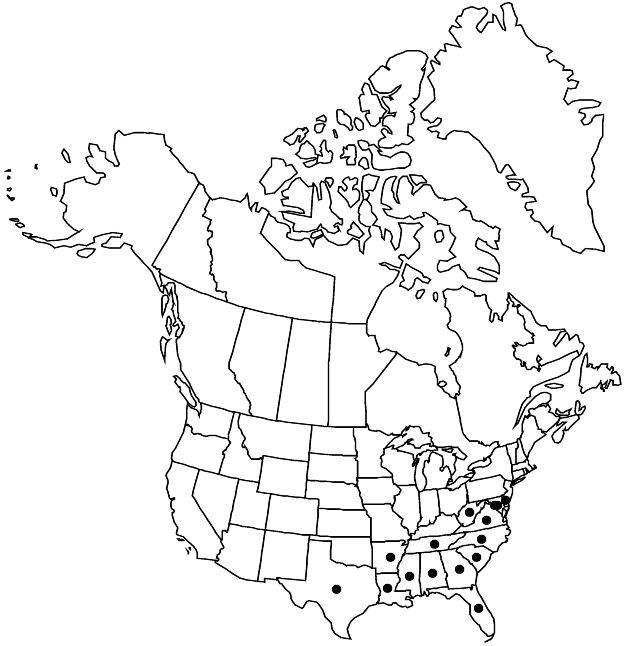Difference between revisions of "Drosera capillaris"
in J. Lamarck et al., Encycl. 6: 299. 1804.
FNA>Volume Importer |
FNA>Volume Importer |
||
| Line 24: | Line 24: | ||
|elevation=0–300 m | |elevation=0–300 m | ||
|distribution=Ala.;Ark.;Del.;D.C.;Fla.;Ga.;La.;Md.;Miss.;N.C.;S.C.;Tenn.;Tex.;Va.;W.Va.;Mexico;West Indies;Central America;South America. | |distribution=Ala.;Ark.;Del.;D.C.;Fla.;Ga.;La.;Md.;Miss.;N.C.;S.C.;Tenn.;Tex.;Va.;W.Va.;Mexico;West Indies;Central America;South America. | ||
| − | |discussion=<p>Drosera capillaris is the most-frequently encountered species of the genus in the South in moist habitats that can support carnivorous plants, especially in fire-maintained pinelands. Plants can be quite small, or form surprisingly large and robust rosettes (to 12 cm broad) in some places along the Gulf Coast. It is disjunct from the Coastal Plain to Arkansas and Tennessee, as are several other species from coastal wetland habitats. Since the leaf blades of D. capillaris can be somewhat orbiculate, it may be confused with the much more northern D. rotundifolia, which grows more typically in sphagnum (although in its northern range it often grows on moist sand substrates), has adnate stipules, white flowers, and forms hibernaculae.</p><!-- | + | |discussion=<p><i>Drosera capillaris</i> is the most-frequently encountered species of the genus in the South in moist habitats that can support carnivorous plants, especially in fire-maintained pinelands. Plants can be quite small, or form surprisingly large and robust rosettes (to 12 cm broad) in some places along the Gulf Coast. It is disjunct from the Coastal Plain to Arkansas and Tennessee, as are several other species from coastal wetland habitats. Since the leaf blades of <i>D. capillaris</i> can be somewhat orbiculate, it may be confused with the much more northern <i>D. rotundifolia</i>, which grows more typically in sphagnum (although in its northern range it often grows on moist sand substrates), has adnate stipules, white flowers, and forms hibernaculae.</p><!-- |
| − | --><p>Drosera capillaris is easy to grow, often behaving as an annual.</p> | + | --><p><i>Drosera capillaris</i> is easy to grow, often behaving as an annual.</p> |
|tables= | |tables= | ||
|references= | |references= | ||
| Line 49: | Line 49: | ||
|publication year=1804 | |publication year=1804 | ||
|special status= | |special status= | ||
| − | |source xml=https://jpend@bitbucket.org/aafc-mbb/fna-data-curation.git/src/ | + | |source xml=https://jpend@bitbucket.org/aafc-mbb/fna-data-curation.git/src/8f726806613d60c220dc4493de13607dd3150896/coarse_grained_fna_xml/V6/V6_798.xml |
|genus=Drosera | |genus=Drosera | ||
|species=Drosera capillaris | |species=Drosera capillaris | ||
Revision as of 17:50, 18 September 2019
Plants not forming winter hibernaculae, rosettes (2–)3–4(–12) cm diam.; stem base not bulbous-cormose. Leaves prostrate; stipules free from or adnate to petioles to 1 mm, then breaking into setaceous segments 3–5 mm; petiole differentiated from blade, 0.6–4 cm, sparsely glandular-pilose; blade broadly spatulate to orbiculate, 0.5–1 cm × 3–5 mm, usually at least slightly longer than broad, usually shorter than petiole. Inflorescences 2–20-flowered; scapes 4–20(–35) cm, glabrous. Flowers 10 mm diam.; sepals connate basally, oblong-elliptic, 3–4 × 1–2 mm, apex obtuse, glabrous; petals usually pink, sometimes white, obovate, 6–7 × 2–3 mm. Capsules 4–5 mm, longer than sepals. Seeds brown, ellipsoid to oblong-ovoid, asymmetric, 0.4–0.5 mm, coarsely papillose-corrugated, 14–16-ridged. 2n = 20.
Phenology: Flowering May–Aug.
Habitat: Sandy soil of pine flatwoods and savannas, seepage slopes, peat-sedge bogs, pocosin borders, wet, sandy ditches
Elevation: 0–300 m
Distribution

Ala., Ark., Del., D.C., Fla., Ga., La., Md., Miss., N.C., S.C., Tenn., Tex., Va., W.Va., Mexico, West Indies, Central America, South America.
Discussion
Drosera capillaris is the most-frequently encountered species of the genus in the South in moist habitats that can support carnivorous plants, especially in fire-maintained pinelands. Plants can be quite small, or form surprisingly large and robust rosettes (to 12 cm broad) in some places along the Gulf Coast. It is disjunct from the Coastal Plain to Arkansas and Tennessee, as are several other species from coastal wetland habitats. Since the leaf blades of D. capillaris can be somewhat orbiculate, it may be confused with the much more northern D. rotundifolia, which grows more typically in sphagnum (although in its northern range it often grows on moist sand substrates), has adnate stipules, white flowers, and forms hibernaculae.
Drosera capillaris is easy to grow, often behaving as an annual.
Selected References
None.